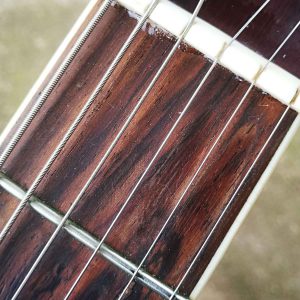Alright. Let’s jump to this wide topic. It’s important to think from the beginning about what kind of strings do you want, because many things, like the stability of body and neck or the attachment of the strings, are changing with this decision.
And one more tip right before we go into details: Strings are one of the easiest way to improve the sound (also afterwards). If you started with random nylon, a change to professional strings will be drastically remarkable. So if you are not going for full no-budget solutions, consider good strings, even for instruments out of trash.
Metal strings
What to consider, when using metal strings?
- They have a loud and crispy sound. That’s good so far.
- At one end of the string, there is a small ring to attach them to the bridge or the body. There are different ways to do so, more about this in the „bridge“ section.
- Metal strings have a high tension. The body and the neck need to be strong enough, not to bend in time.
- The tuners as well need to be able to stand this high tension.
- Loud, bright sound
- Cheaper than nylon strings
- Metal strings requier more precision on the fretboard
- Your fingers need quite a bit training, otherwise the metal strings can feel quite cutting
- Most string tension. If you are not sure about the stability of your body, better go for nylon strings
Nylon strings
- Less string tension, so better for weaker body and neck constructions.
- The amount of precision needed on the frets is a little lower
- More expensive, compared to steel strings
Phishing line, generic nylon strings
I would say, those are fine for real no-budget trash instruments. I did some Ukes with fishing line, and it’s kind of working. For guitars, you will run in to difficulties finding thick nylon for the lower strings, which are normally wrapped with wire.
Too thin string for a lower note will leave the string with too less tension to sound well. Too thick string for a higher note will just rip the string somewhere
- Cheap or even free!
- Reduced sound quality.
- Hard to find the right thickness for each string in order to have a good tension.
Generic strings, rubber band…
- Just don’t! Doesn’t sound at all or really shitty!
Skale lengh
This is the distance between nut and bridge. More precisely, it’s the length of the free swinging strings.
The measurements below are standards, and you can buy strings for exactly these lengths. Still, you don’t need to stick 100% on these numbers. Making it a little longer will make the strings tighter with a higher risk of breaking. Shortening will reduce the tension, but the sound becomes quieter.
Ukuleles | Scale length | Standart Tuning |
|---|---|---|
| Sopranino | 28 | G C E A |
| Soprano | 35 | G C E A |
| Concert | 38 | G C E A |
| Tenor | 43 | G C E A |
| Guitarlele | 45 | A D G C E A |
| Baritone | 51 | D G B E |
| Guitar Uke | 56 | G C E A |
G C E A is the standard tuning of Ukuleles. This is the same as the 4 higher strings on the fifth fret of a guitar. So you can actually play Uke chords on a guitar as well. From Sopranino till Tenor Uke the tuning is exactly the same. The baritone ukulele is an exception. It is 5 semitones lower and therefore corresponds exactly to the lower four strings of the guitar (only an octave higher).
The guitar ukulele is exactly one octave lower than the standard ukulele. To make this possible, E A D and G strings of a normal guitar string set are used and retuned to G C E A. In order to avoid the string tension becoming too high, the scale length has to be shortened to approx. 53 – 56 cm compared to a normal guitar. Either the high or the low E string of the guitar string set can be used.
Guitars | Scale length | Standart Tuning |
|---|---|---|
| Guitar (steel strings) | 61 | E A D G B E |
| Guitar 4/4 (nylon strings) This is the standart full size | 65 | E A D G B E |
| Guitar 7/8 | 63 | |
| Guitar 3/4 | 58 | |
| Guitar 1/2 | 53 | |
| Guitar 1/4 | 48 | |
| Guitar 1/8 | 44 | |
| Mandoline | G D A E |
Instruments | Scale length | Standart Tuning |
|---|---|---|
| Banjo | 58 – 81 | E A D G B E |
| Mandoline | 33 – 35 | G D A E |
Tuning
Even if guitars have mostly 6 and ukuleles 4 strings, there is no reason to feel limited to this. For example, for an ordinary guitar strummer, it can be quite nice to just make a 5-string guitar and kick the deepest string. For many chords, you are anyway not allowed to use it.
| Standart guitar | E – A – D – G – B – E |
| Standart ukulele | G – C – E – A |
| Open G (for playing with a bottleneck) | D – G – D – G – B – D |

